
(Photo Credit: USDA/Scott Bauer)
The distance between Silicon Valley and the San Joaquin Valley is more than 150 miles. But some may say the distance is more than miles: It is the difference between Apple and an apple. But in the past several years, the two valleys have become closer as two of state’s biggest industries are converging.
Agriculture in the San Joaquin Valley alone is a $30-billion industry (statewide it is $50 billion). And, to make sure that the industry is at its most efficient, technology has been developed to be used in all aspects of farming, including production, food safety, energy use, environmental impact and, most importantly, water.
Robert Tse of USDA Rural Development California works to develop economic strategies for regional rural areas such as the San Joaquin Valley. He sees the best opportunity for regional economic development is the crossover between agriculture and technology.
“As a farmer, you’re in there year after year after year,” said Tse. “So inherently, your approach is supposed to be sustainable. And that’s not a new tradition, but it’s getting more refined with the technology.”
One of the new concepts is what’s called “precision agriculture.” This is where meters can tell the farmer how much water or fertilizer is needed, not only on a specific area of a farm, but down to a specific plant. This keeps the crops from being over- or under-watered and fertilized, saving not only money, but also output into the environment.
Fifth-generation cattle rancher and farmer Kenny Watkins uses technology on his farm in Linden, which is east of Stockton. He is also the First Vice President of the California Farm Bureau Federation, so he is contact with other area farmers and knows first-hand how farming is changing. Watkins said, “The tractors are guided by GPS, the harvesters are guided by GPS. The fuel efficiency and the time efficiency saved with no overlaps and no gaps and no wasted time, it’s had an impact.”
He also touted the use of precision agriculture, “Before you used to watch the plants to figure out how much water to give them and when to give it. You got the experience and you knew how much to water and when. Now we’ve got moisture meters and probes in the soils.”
Tse added that the use of technology makes sense, “It is sustainable from an economic standpoint. It’s sustainable from an agronomy standpoint and it’s sustainable from an environmental standpoint, because any one of those three things, if you didn’t follow it, you wouldn’t have a farm anymore, you would be out of business.”
The development of the San Joaquin Valley’s agricultural technology is coming from many different venues. California State University, Fresno and University of California Davis are vital in working with local farmers to develop ways to use tech. And two of the area’s best assets are the national research laboratories, Lawrence Livermore and the Lawrence Berkeley, which work on a number of projects, including ag-tech.
Additionally, Tse added the current drought is driving a lot of innovation. “Obviously, every drop counts, so if you can afford it, you’re going to have to use the latest, best irrigation technology that maximizes the utilization of the water regardless of where it comes from.”
He called the drought a “disruptive event,” which is forcing change. “It’s not necessarily a bad thing from the standpoint of a business because it means business opportunity for those who recognize it.” He said farmers in the San Joaquin Valley who adopt this new technology to help them get through the drought will likely be more efficient and benefit long run.
The convergence of technology and agriculture benefits the region in many ways. It is creating technology jobs in a region traditionally not know for tech and, at the same time, making sure traditional farms are sustainable for generations to come.

